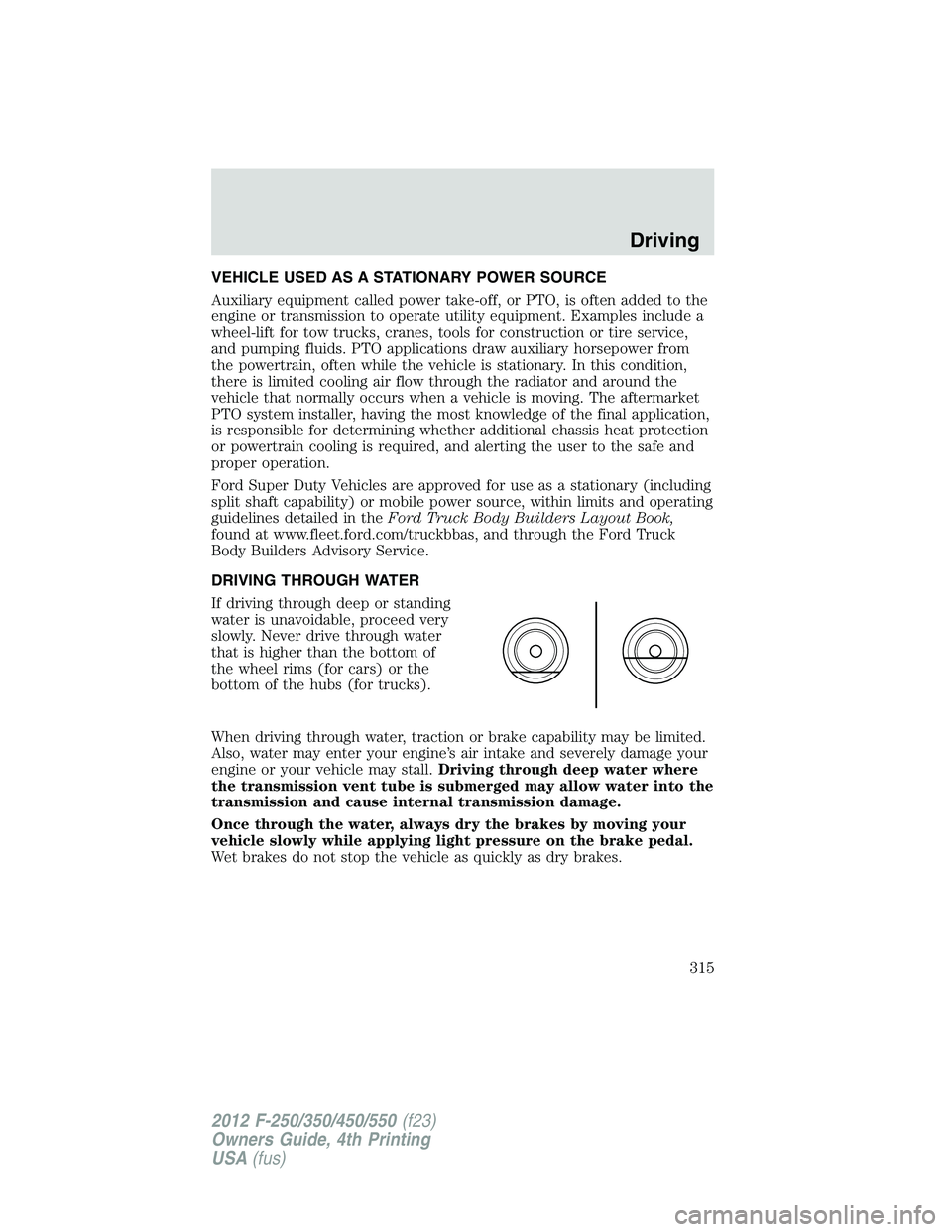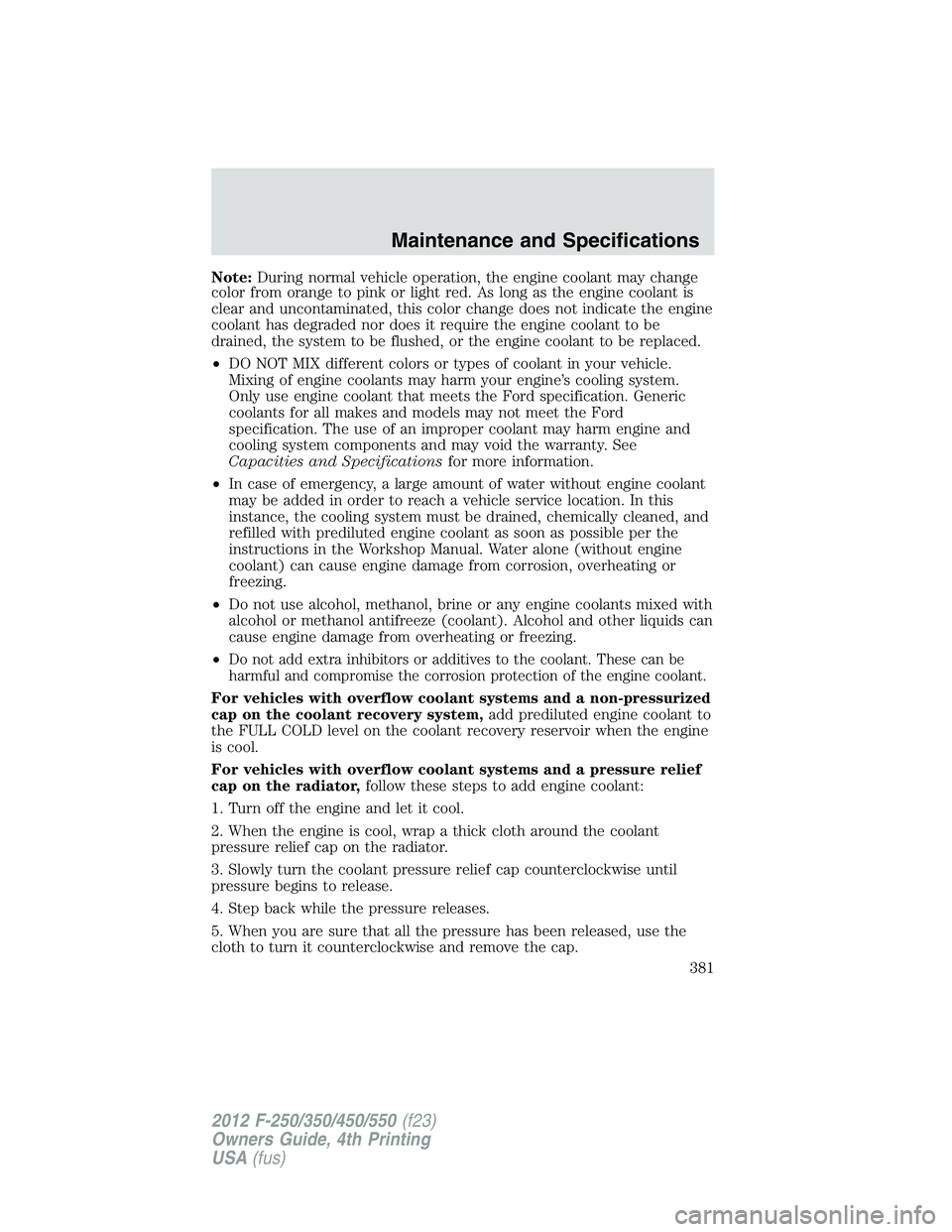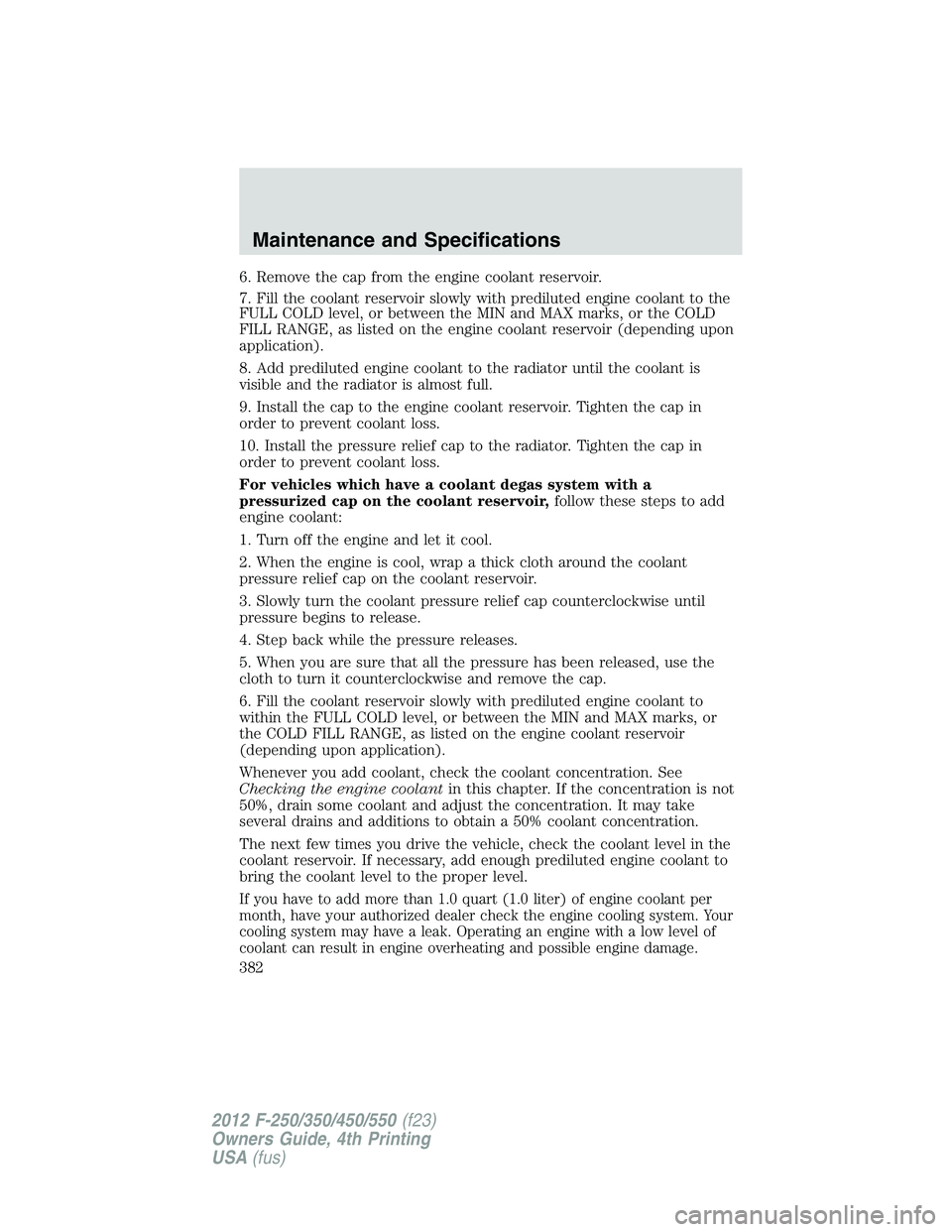2012 FORD F550 radiator
[x] Cancel search: radiatorPage 94 of 448

Replacing headlamps, park lamps, turn lamps
1. Make sure that the exterior lamps are off, then open the hood.
2. Using masking tape or a marker,
make an alignment mark between
one of the grille brackets and the
vehicle radiator support to ensure
correct grille alignment during
re-assembly. Do not scratch the
black coating from the radiator
support.
3. Remove the two grille to
headlamp assembly push pins and
the four bolts attaching the top of
the grille to the radiator support.
4. Pull the top of the grille forward to gain access to the lower grille
spring clips.
5. Depress the spring clips through the lower inner grille access openings
using a flat head screwdriver.
6. Pull the grill straight out to remove.
7. Remove the four bolts from the
headlamp assembly.
8. Pull the assembly straight out
disengaging one snap clip from the
fender.
9. Disconnect the electrical
connector by squeezing the release
tab and pushing the connector
forward, then pulling it rearward.Lights
94
2012 F-250/350/450/550 (f23)
Owners Guide, 4th Printing
USA (fus)
Page 315 of 448

VEHICLE USED AS A STATIONARY POWER SOURCE
Auxiliary equipment called power take-off, or PTO, is often added to the
engine or transmission to operate utility equipment. Examples include a
wheel-lift for tow trucks, cranes, tools for construction or tire service,
and pumping fluids. PTO applications draw auxiliary horsepower from
the powertrain, often while the vehicle is stationary. In this condition,
there is limited cooling air flow through the radiator and around the
vehicle that normally occurs when a vehicle is moving. The aftermarket
PTO system installer, having the most knowledge of the final application,
is responsible for determining whether additional chassis heat protection
or powertrain cooling is required, and alerting the user to the safe and
proper operation.
Ford Super Duty Vehicles are approved for use as a stationary (including
split shaft capability) or mobile power source, within limits and operating
guidelines detailed in the Ford Truck Body Builders Layout Book,
found at www.fleet.ford.com/truckbbas, and through the Ford Truck
Body Builders Advisory Service.
DRIVING THROUGH WATER
If driving through deep or standing
water is unavoidable, proceed very
slowly. Never drive through water
that is higher than the bottom of
the wheel rims (for cars) or the
bottom of the hubs (for trucks).
When driving through water, traction or brake capability may be limited.
Also, water may enter your engine’s air intake and severely damage your
engine or your vehicle may stall. Driving through deep water where
the transmission vent tube is submerged may allow water into the
transmission and cause internal transmission damage.
Once through the water, always dry the brakes by moving your
vehicle slowly while applying light pressure on the brake pedal.
Wet brakes do not stop the vehicle as quickly as dry brakes. Driving
315
2012 F-250/350/450/550 (f23)
Owners Guide, 4th Printing
USA (fus)
Page 317 of 448

Operating the vehicle with the snowplow attached
Do not use your vehicle for snow removal until it has been driven at
least 500 miles (800 km).
The attached snowplow blade restricts airflow to the radiator, and may
cause the engine to run at a higher temperature: Attention to engine
temperature is especially important when outside temperatures are
above freezing. Angle the blade to maximize airflow to the radiator and
monitor engine temperature to determine whether a left or right angle
provides the best performance.
Follow the severe duty schedule in your scheduled maintenance
information for engine oil and transmission fluid change intervals.
Snowplowing with your airbag-equipped vehicle
Your vehicle is equipped with a driver and passenger airbag
Supplemental Restraint System (SRS) The SRS is designed to activate in
certain frontal and offset frontal collisions when the vehicle sustains
sufficient longitudinal deceleration.
Careless or high speed driving while plowing snow which results in
sufficient vehicle decelerations can deploy the airbag. Such driving also
increases the risk of accidents.
WARNING: All occupants of the vehicle, including the driver,
should always properly wear their safety belts, even when an air
bag supplemental restraint system (SRS) is provided.
Never remove or defeat the “tripping mechanisms” designed into the
snow removal equipment by its manufacturer. Doing so may cause
damage to the vehicle and the snow removal equipment as well as
possible airbag deployment.
WARNING: Do not attempt to service, repair, or modify the air
bag supplemental restraint system (SRS) or its fuses. See your
Ford or Lincoln Mercury dealer.
WARNING: Additional equipment such as snowplow equipment
may effect the performance of the airbag sensors increasing the
risk of injury. Please refer to the Body Builders Layout Book for
instructions about the appropriate installation of additional equipment. Driving
317
2012 F-250/350/450/550 (f23)
Owners Guide, 4th Printing
USA (fus)
Page 381 of 448

Note: During normal vehicle operation, the engine coolant may change
color from orange to pink or light red. As long as the engine coolant is
clear and uncontaminated, this color change does not indicate the engine
coolant has degraded nor does it require the engine coolant to be
drained, the system to be flushed, or the engine coolant to be replaced.
• DO NOT MIX different colors or types of coolant in your vehicle.
Mixing of engine coolants may harm your engine’s cooling system.
Only use engine coolant that meets the Ford specification. Generic
coolants for all makes and models may not meet the Ford
specification. The use of an improper coolant may harm engine and
cooling system components and may void the warranty. See
Capacities and Specifications for more information.
• In case of emergency, a large amount of water without engine coolant
may be added in order to reach a vehicle service location. In this
instance, the cooling system must be drained, chemically cleaned, and
refilled with prediluted engine coolant as soon as possible per the
instructions in the Workshop Manual. Water alone (without engine
coolant) can cause engine damage from corrosion, overheating or
freezing.
• Do not use alcohol, methanol, brine or any engine coolants mixed with
alcohol or methanol antifreeze (coolant). Alcohol and other liquids can
cause engine damage from overheating or freezing.
• Do not add extra inhibitors or additives to the coolant. These can be
harmful and compromise the corrosion protection of the engine coolant.
For vehicles with overflow coolant systems and a non-pressurized
cap on the coolant recovery system, add prediluted engine coolant to
the FULL COLD level on the coolant recovery reservoir when the engine
is cool.
For vehicles with overflow coolant systems and a pressure relief
cap on the radiator, follow these steps to add engine coolant:
1. Turn off the engine and let it cool.
2. When the engine is cool, wrap a thick cloth around the coolant
pressure relief cap on the radiator.
3. Slowly turn the coolant pressure relief cap counterclockwise until
pressure begins to release.
4. Step back while the pressure releases.
5. When you are sure that all the pressure has been released, use the
cloth to turn it counterclockwise and remove the cap. Maintenance and Specifications
381
2012 F-250/350/450/550 (f23)
Owners Guide, 4th Printing
USA (fus)
Page 382 of 448

6. Remove the cap from the engine coolant reservoir.
7. Fill the coolant reservoir slowly with prediluted engine coolant to the
FULL COLD level, or between the MIN and MAX marks, or the COLD
FILL RANGE, as listed on the engine coolant reservoir (depending upon
application).
8. Add prediluted engine coolant to the radiator until the coolant is
visible and the radiator is almost full.
9. Install the cap to the engine coolant reservoir. Tighten the cap in
order to prevent coolant loss.
10. Install the pressure relief cap to the radiator. Tighten the cap in
order to prevent coolant loss.
For vehicles which have a coolant degas system with a
pressurized cap on the coolant reservoir, follow these steps to add
engine coolant:
1. Turn off the engine and let it cool.
2. When the engine is cool, wrap a thick cloth around the coolant
pressure relief cap on the coolant reservoir.
3. Slowly turn the coolant pressure relief cap counterclockwise until
pressure begins to release.
4. Step back while the pressure releases.
5. When you are sure that all the pressure has been released, use the
cloth to turn it counterclockwise and remove the cap.
6. Fill the coolant reservoir slowly with prediluted engine coolant to
within the FULL COLD level, or between the MIN and MAX marks, or
the COLD FILL RANGE, as listed on the engine coolant reservoir
(depending upon application).
Whenever you add coolant, check the coolant concentration. See
Checking the engine coolant in this chapter. If the concentration is not
50%, drain some coolant and adjust the concentration. It may take
several drains and additions to obtain a 50% coolant concentration.
The next few times you drive the vehicle, check the coolant level in the
coolant reservoir. If necessary, add enough prediluted engine coolant to
bring the coolant level to the proper level.
If you have to add more than 1.0 quart (1.0 liter) of engine coolant per
month, have your authorized dealer check the engine cooling system. Your
cooling system may have a leak. Operating an engine with a low level of
coolant can result in engine overheating and possible engine damage.Maintenance and Specifications
382
2012 F-250/350/450/550 (f23)
Owners Guide, 4th Printing
USA (fus)
Page 427 of 448

Check every six months
Parking brake for proper operation
Safety belts and seat latches for wear and function
Safety warning lamps (brake, ABS, airbag, safety belt) for operation
Washer spray/wiper operation; clean or replace blades as necessary
Multi-point Inspection
In order to keep your vehicle running right, it is important to have the
systems on your vehicle checked regularly. This can help identify
potential issues and prevent major problems. Ford Motor Company
recommends the following multi-point inspection be performed at every
scheduled maintenance interval to help make sure your vehicle keeps
running great.
Multi-point inspection – Recommended each visit
Accessory drive belt(s) Half-shaft dust boots (if equipped)
Battery performance Horn operation
Clutch operation (if equipped) Radiator, cooler, heater and A/C hoses
Engine air filter Suspension component for leaks or
damage
Exhaust system Steering and linkage
Exterior lamps and hazard
warning system operation Tires for wear and proper pressure,
including spare
Fluid levels*; fill if necessary Windshield for cracks, chips or pits
For oil and fluid leaks Washer spray and wiper operation *
Brake, coolant recovery reservoir, manual and automatic transmission
(with an underhood dipstick), power steering (if equipped) and window
washer
Be sure to ask your dealership service advisor or technician about the
multi-point vehicle inspection. It’s a comprehensive way to perform a
thorough inspection of your vehicle. It’s your checklist that gives you
immediate feedback on the overall condition of your vehicle. You’ll know
what’s been checked, what’s okay, as well as those things that may
require future or immediate attention. The multi-point vehicle inspection
is one more way to keep your vehicle running great! Scheduled Maintenance
427
2012 F-250/350/450/550 (f23)
Owners Guide, 4th Printing
USA (fus)